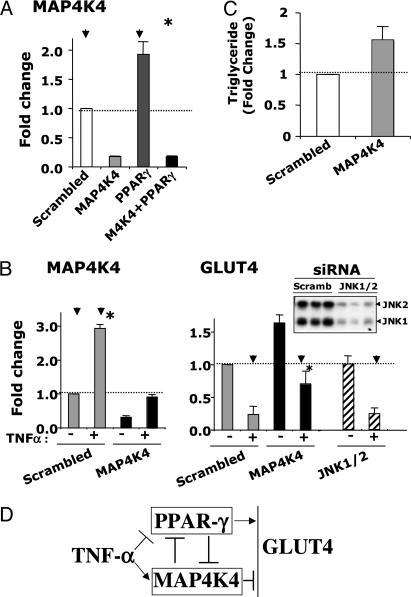Fig. 6.
TNF-α treatment and depletion of PPARγ protein enhances MAP4K4/NIK expression in cultured adipocytes. (A) Adipocytes were transfected with scrambled siRNA or siRNA directed against MAP4K4/NIK, PPARγ, and MAP4K4/NIK plus PPARγ and replated for 72 h, as described in Experimental Procedures and Fig. 1. RNA was extracted, and the relative abundance of mRNA for MAP4K4/NIK was evaluated by real-time PCR analysis. All data are represented as bar graphs, and results are the average of four independent experiments. (B) TNF-α induced expression of MAP4K4/NIK. Transfected adipocytes were incubated in the absence or presence of 10 ng/ml TNF-α for 24 h. RNA was extracted, and the relative amount of mRNAs for MAP4K4/NIK and GLUT4 were evaluated by real-time PCR. Data are the averages of three independent experiments and are shown as fold changes over the scrambled siRNA condition. Down-regulation of GLUT4 by TNF-α treatment were significantly impaired (∗, P < 0.05) in the absence of MAP4K4, but not in the absence of JNK1 or JNK2 (scrambled RNAi control, MAP4K4 and JNK 1/2 depletion conditions are indicated by arrowheads). (Upper) Depletion of JNK1/2 protein by siRNA-mediated gene silencing. Image depicts Western blot analysis of scrambled control and JNK1/JNK2-knockdown cell lysates, using anti-JNK1/JNK2 antibody. (C) Quantification of intracellular triglyceride content for cells transfected with scrambled siRNA or MAP4K4/NIK siRNA. Transfected cells were replated for 72 h, and then intracellular triglyceride content was quantified as described in Methods. Data are means ± SE of values from three independent experiments. (D) A proposed model for the role of MAP4K4/NIK as a negative regulator of PPARγ, GLUT4 expression, and adipogenesis.

